"Two weeks for future": Me, my son and our tandem

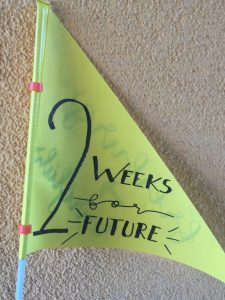 The aim of my trip was to be the journey itself. And I wanted to test whether a two-week cycle trip was possible with my autistic son, and to find out whether we could enjoy the time or eventually have to accept that next time we simply take the train again and manage without our own transport at the holiday destination.
The aim of my trip was to be the journey itself. And I wanted to test whether a two-week cycle trip was possible with my autistic son, and to find out whether we could enjoy the time or eventually have to accept that next time we simply take the train again and manage without our own transport at the holiday destination.
Besides, I thought that this trip might also allow us to meet people. The end of the cycle ride and of the first week was to be followed by a week on an organic farm in the Westerwald. A special place for a rather different trip. A place where sustainability is the natural way to live. A place where one can recharge one’s batteries and enjoy life with all one’s senses. A place which I am already looking forward to visiting again at Christmas.
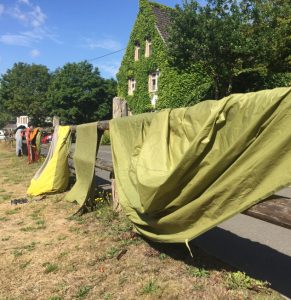 Firstly, I should say that I love going on camping trips on my bike. That is no problem for me. But we have never yet dared to do it with our son, since his challenging autistic behaviour demands a great deal of energy. Incidentally, our son still has to wear nappies, which have to be changed. In recent years we – my partner and I – have allowed each other some time out to go camping with our bikes.
Firstly, I should say that I love going on camping trips on my bike. That is no problem for me. But we have never yet dared to do it with our son, since his challenging autistic behaviour demands a great deal of energy. Incidentally, our son still has to wear nappies, which have to be changed. In recent years we – my partner and I – have allowed each other some time out to go camping with our bikes.
Before being ready to set off, we had to find solutions for a number of challenges.
For example, my son still doesn’t help with the pedalling. I’m used to that and my fitness level is such that I can even manage 600 to 800 metres of ascent with him. However, we need a tent, two sleeping bags and thermal mats, waterproofs and a change of clothing for two people, drinking bottles with contents, food, a muesli bowl, two or three toys, swimsuits, towels, medication, first aid kit and the nappies. Carrying nappies for two weeks – impossible. So I packed nappies for one week and sent the second batch to a place where I was planning an overnight stop at a youth hostel.
I don’t want to camp all the time, anyway, as I have to put up and take down the tent on my own and, on top of that, I can’t let my son out of my sight.
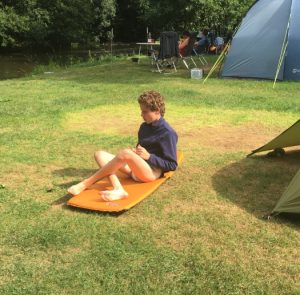 Nevertheless, the rest of the luggage is still more than will fit in two panniers: about another 13 to 15 kilos in all. What I needed was a motorised trailer. Someone else is bound to have thought of that already. Thank heavens for all the creators of internet search engines: a small start-up in Bavaria retrofits luggage and child bike trailers with an electric motor and sells a cool single wheel trailer already equipped with one. The great thing about this drive kit is this: a transmitter attached to the pedal tells the e-motor how fast it should drive the trailer wheel. This prevents the trailer from pushing or pulling back, so the luggage actually travels at the same speed.
Nevertheless, the rest of the luggage is still more than will fit in two panniers: about another 13 to 15 kilos in all. What I needed was a motorised trailer. Someone else is bound to have thought of that already. Thank heavens for all the creators of internet search engines: a small start-up in Bavaria retrofits luggage and child bike trailers with an electric motor and sells a cool single wheel trailer already equipped with one. The great thing about this drive kit is this: a transmitter attached to the pedal tells the e-motor how fast it should drive the trailer wheel. This prevents the trailer from pushing or pulling back, so the luggage actually travels at the same speed.
A start-up is my saviour
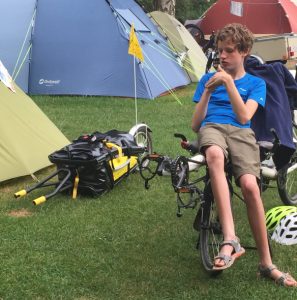 I am naturally a bit worried about how the combination of tandem with recumbent at the front and the trailer will handle. According to the test review the single wheel trailer available is exceptionally stable and easy to steer. However, to be on the safe side, I pick up the phone and am put through to someone working at the company who actually already owns my special tandem. Apparently the combination of Pino (the name of the tandem) and Topeak luggage trailers is easy to manoeuvre. The e-motor from the Bavarian start-up solves all my problems.
I am naturally a bit worried about how the combination of tandem with recumbent at the front and the trailer will handle. According to the test review the single wheel trailer available is exceptionally stable and easy to steer. However, to be on the safe side, I pick up the phone and am put through to someone working at the company who actually already owns my special tandem. Apparently the combination of Pino (the name of the tandem) and Topeak luggage trailers is easy to manoeuvre. The e-motor from the Bavarian start-up solves all my problems.
Somehow, just planning the route was exciting.
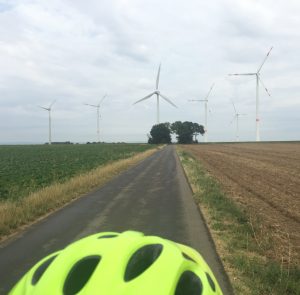 When I was planning the actual tour I noticed that I was uncomfortable with my tried and tested formula: choose the start and finish, roughly plan out the first section based on the selection criterion “scenic route with least possible traffic”, then everything else a day at a time. I realised that I needed to know where I will get to each evening and whether we will be spending the night in the tent, with friends, with friends of friends, at a youth hostel or, if necessary, in a guesthouse or Airbnb.
When I was planning the actual tour I noticed that I was uncomfortable with my tried and tested formula: choose the start and finish, roughly plan out the first section based on the selection criterion “scenic route with least possible traffic”, then everything else a day at a time. I realised that I needed to know where I will get to each evening and whether we will be spending the night in the tent, with friends, with friends of friends, at a youth hostel or, if necessary, in a guesthouse or Airbnb.
The trial run
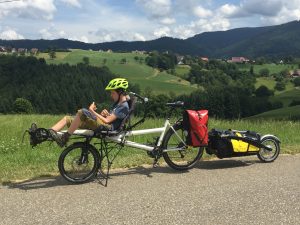 A trial run from Lake Schluchsee over the Feldberg to Freiburg tells me how many kilometres and metres of ascent we can do in a day, if we build in stops for swimming, snacks and ice cream, and other things. We also tested the quality of the road surfaces. Forestry tracks and wide-ish, not too steep wooded routes, even with a few roots or stones, did not present any problem for the bike.
A trial run from Lake Schluchsee over the Feldberg to Freiburg tells me how many kilometres and metres of ascent we can do in a day, if we build in stops for swimming, snacks and ice cream, and other things. We also tested the quality of the road surfaces. Forestry tracks and wide-ish, not too steep wooded routes, even with a few roots or stones, did not present any problem for the bike.
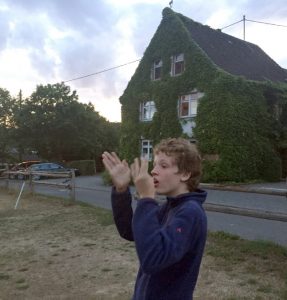 Somehow, just planning the route was exciting. I then planned the actual tour on the basis of what I had learnt on the trial run, using the komoot cycle route planner. This planner allows you to choose between racing bikes, mountain bikes and tourers, and with the tourer version you also get route suggestions which follow forestry tracks or farm lanes. It is nice, too, that users add places to visit onto it: children’s attractions, such as a fantastic adventure playground, nice picnic sites and occasionally an ice cream parlour.
Somehow, just planning the route was exciting. I then planned the actual tour on the basis of what I had learnt on the trial run, using the komoot cycle route planner. This planner allows you to choose between racing bikes, mountain bikes and tourers, and with the tourer version you also get route suggestions which follow forestry tracks or farm lanes. It is nice, too, that users add places to visit onto it: children’s attractions, such as a fantastic adventure playground, nice picnic sites and occasionally an ice cream parlour.
I chose some stops because of free or cheap places to stay overnight: with relatives, friends and friends of friends, or youth hostels and campsites. Opportunities for swimming often influenced the route taken on a stage.
En route
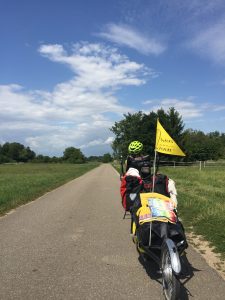 Eventually I decided on a version with a total length of 400 km over 13 days, with a rest day at an idyllic campsite on the river Wied. The stretch ran from Freiburg into the Black Forest, with a swimming stop at St. Märgen natural outdoor pool, then on via Baar to Rottweil. Here we made our third overnight stop in a beautiful garden belonging to friends of friends.
Eventually I decided on a version with a total length of 400 km over 13 days, with a rest day at an idyllic campsite on the river Wied. The stretch ran from Freiburg into the Black Forest, with a swimming stop at St. Märgen natural outdoor pool, then on via Baar to Rottweil. Here we made our third overnight stop in a beautiful garden belonging to friends of friends.
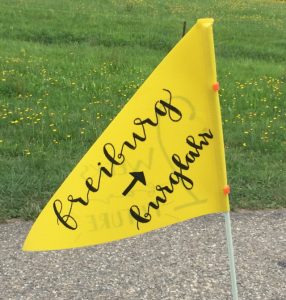 From there the route climbed again through the Black Forest to Freudenstadt, down the Murg valley, then followed the foothills past Karlsruhe and through a Special Area of Conservation in the Rhine Valley to Speyer. We crossed the Rhine before Speyer on a cultural treasure: a ferry for pedestrians and cyclists. From Speyer we spent three days crossing the Kurpfalz region. I decided then, in the confusing network of farm lanes, that for next time I would get myself a phone mount and power bank so that I can use the SatNav now and again.
From there the route climbed again through the Black Forest to Freudenstadt, down the Murg valley, then followed the foothills past Karlsruhe and through a Special Area of Conservation in the Rhine Valley to Speyer. We crossed the Rhine before Speyer on a cultural treasure: a ferry for pedestrians and cyclists. From Speyer we spent three days crossing the Kurpfalz region. I decided then, in the confusing network of farm lanes, that for next time I would get myself a phone mount and power bank so that I can use the SatNav now and again.
From Bingen we rode for two days along the Rhine past the Lorelei – fabulous scenery. By the second day in the narrow Rhine valley I was already cursing the amount of traffic going past on the road right next to the cycle path. However, at Lahnstein the route left the busy roads while continuing to follow the Rhine, until we turned off into the Westerwald after Koblenz. We had a day’s rest at a campsite fittingly called Zum Stillen Winkel (The Quiet Corner), before completing the last stage.
At the finish we were met with huge cheers and “Jenny, you’ve made it!”, as well as delicious cheese and ham pancakes, salad and apple juice. We had made it.
What I learnt on the way
Interestingly, my son had no problem with getting on the tandem every day and spending every night somewhere different. Even camping in our little two-person tent wasn’t a problem: often my husband and I are shattered for the first few days because our son doesn’t sleep through the night in strange surroundings. During our tour we even managed to sleep through six hours of heavy rain in the night. Of course Felix did become agitated now and again, for example when he wanted to get going, because we had had breakfast and I took too long with the packing.
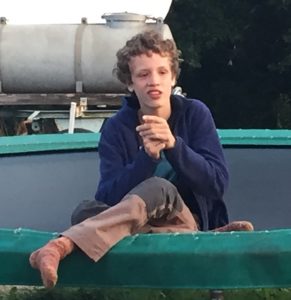
We saw lots of things and almost always found somewhere to swim – or at least paddle – if only the Kneipp pool beside the path in the Murg valley. Fortune smiled on us in this respect, even on one cold, wet day: the youth hostel that we were heading for had an indoor pool, where we were able to have an hour to ourselves, free of charge. There was wonderful orchestral music thrown in, too, as above us enthusiastic young musicians from various countries were rehearsing for a concert.
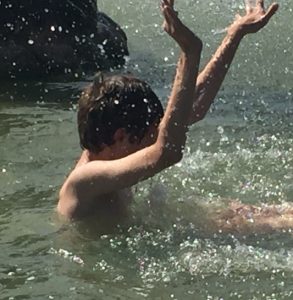
Once, a very nice pensioner who spoke to us outside the supermarket presented us with some energy bars that she had baked herself. Another time, three children who were cycling from Düsseldorf to Baden-Baden with their parents picked us some delicious ripe wild plums that were growing at the rest area where we had all stopped. Several times on our tandem I was spoken to by parents of children with special needs.
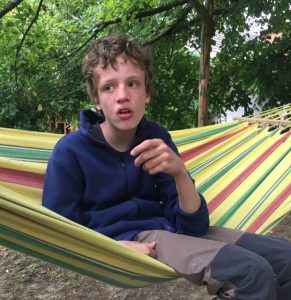
I also received help at the youth hostels, where Felix did not cope well with the eating arrangements: too many young people in relaxed holiday mood, and excited children who pushed their way to the buffet with their parents to grab the dessert or a particular sort of bread roll. Then I had to escape outside, but kind people brought us trays loaded with food.
A restaurant visit in the Pfalz
A change of plan, owing to the weather – we stayed overnight in an old mill converted into a guesthouse instead of on the campsite – meant that the two of us ended up in a restaurant with chic white tablecloths and decorations on the tables. My heart pounded and I could already see a tablecloth being pulled off, and angry looks from couples wanting to enjoy a pleasant child-free evening over a nice meal, because I suspected that the waiting times for the food would be longer than in a pizzeria. But the pretty Rhenish village, with one renovated half-timbered house after another, didn’t have a pizzeria.
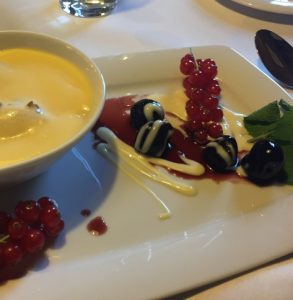
It was Sunday, and we were hungry. I had already decided to turn round and stir some water into the remains of the muesli, hoping that my son was hungry enough. Then the restaurant owner invited me to take a look at the menu and give it a go. I pushed Felix into the furthest corner, moved the glasses and table decorations to safety, and what happened?
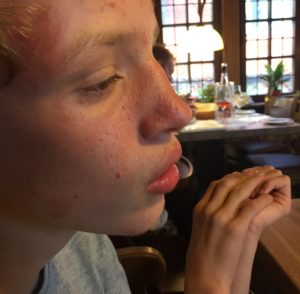
Felix enjoyed the relaxed atmosphere with soft classical Spanish guitar music. He ate three quarters of the “amuse-gueule” and his noodles with relish, as well as some of my food. As I still had some room left, I ordered two desserts as well. To celebrate the day, I treated myself to a “Kir Royale”.
Planning is underway for the next tour
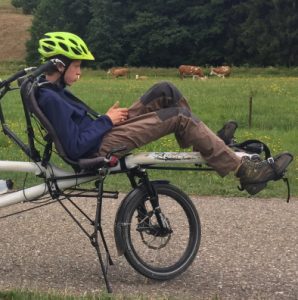 I am planning the next tour now! Sometimes one just needs a little courage and self-confidence. Changes in lifestyle don’t have to mean giving something up. They can also enrich your life. What I would like to see is an open discussion on this subject with no recriminations.
I am planning the next tour now! Sometimes one just needs a little courage and self-confidence. Changes in lifestyle don’t have to mean giving something up. They can also enrich your life. What I would like to see is an open discussion on this subject with no recriminations.
Dr Jenny Teufel is Senior Researcher in the Sustainable Products & Material Flows Division in Freiburg. Her research focuses on sustainable consumption and sustainable products.